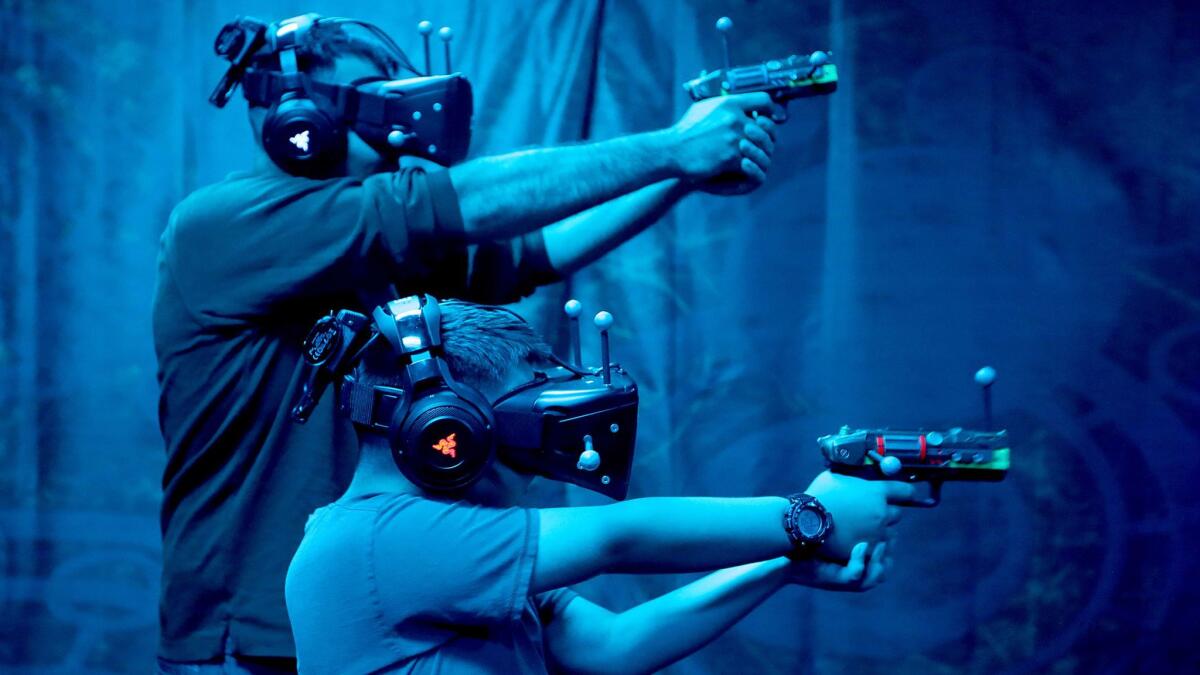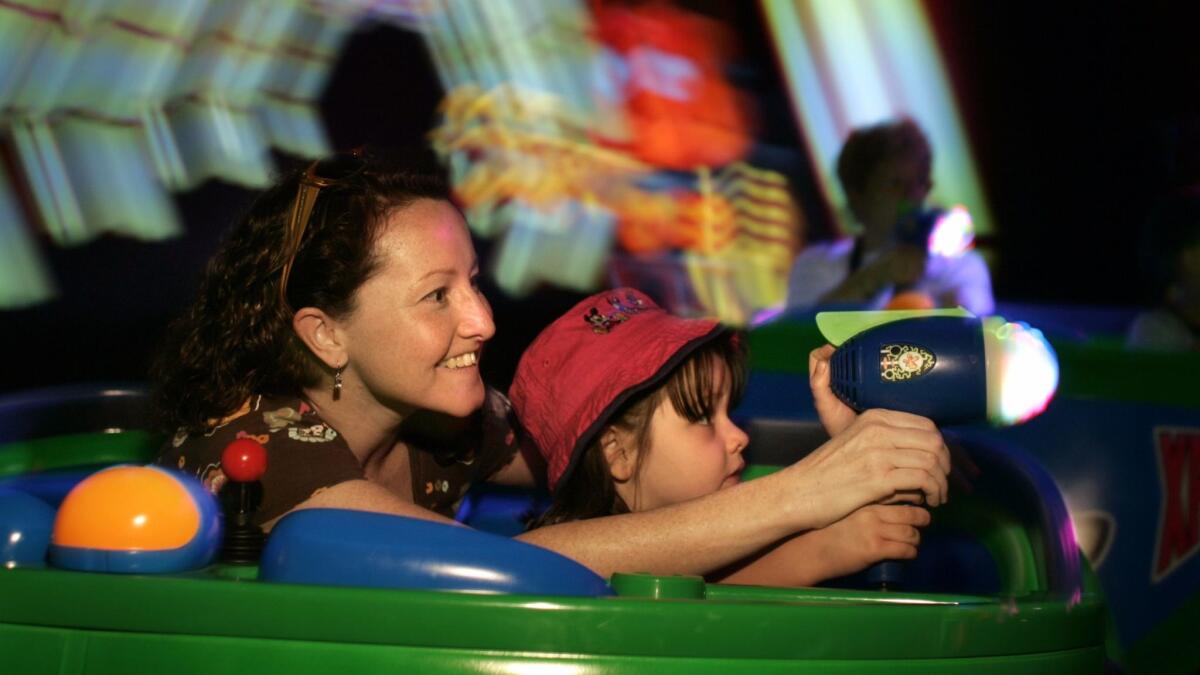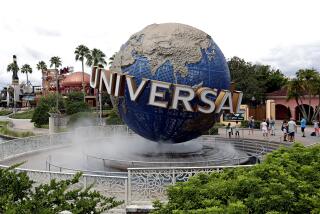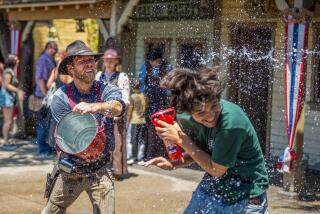Video-game-loving millennials, theme parks are making these attractions just for you

- Share via
The Marine gripped his six-shooter, pointed it at the horizon and took a deep breath.
“Let’s do it,” he barked, kicking off a brief but furious gun battle with a horde of robot cowboys, their eyes glowing red.
Derek Phelps, a leatherneck stationed at Marine Corps Base Camp Pendleton, was not only fighting off an invading robot horde but also his 8-year-old brother, Tyrus, who stood next to him, trying to kill off more invaders than his older brother.
“Ah, first place,” the Marine shouted after finishing the virtual reality game VR Showdown in Ghost Town, the newest attraction at Knott’s Berry Farm in Buena Park.
In the theme park industry, attractions that encourage head-to-head competition are growing in popularity because they entice visitors — particularly video-game-loving millennials — to visit a park repeatedly to improve their score or to beat new challengers.
For regional parks such as Knott’s Berry Farm, attractions that add an interactive gaming element also help them compete against the big-dollar attractions at Disneyland and other destination resorts without breaking the bank.
In Southern California, Knott’s VR Showdown is among three gaming attractions that have launched recently or are scheduled to open this summer. They join two similar competition-based attractions that opened at local parks in the past two years.
Although games with a competitive element go back to the days of the old-fashioned carnival midway, theme parks became interested in keeping score as technology improved and the cost of virtual reality goggles and other components dropped.
In Knott’s VR Showdown, players wearing virtual reality goggles stand in an empty room. Overhead cameras monitor the players’ pistols to track their shots, and the wireless equipment allows players to move around the room. Competing players appear as avatars on the goggles’ screen. A score appears in the goggles at the end of the game.
“The whole notion of tapping into people’s competitive spirits is what motivates it,” said Monty Lunde, chief executive of Technifex, a Valencia company that designs, engineers and produces attractions, with a focus on special effects and interactive systems.
We can deliver now the kind of attraction we couldn’t do 10 years ago.
— Christian Diekmann, Cedar Fair Entertainment
Such attractions aim to entice the burgeoning population of young gamers, and designers say the challenge is to create a superior experience to what the players might get on their home gaming setup.
Fullerton student Emiliano Perez played VR Showdown at Knott’s Berry Farm recently and said it outmatches the virtual soccer games he plays on his home Xbox system. “It’s like you are part of the game,” the 13-year-old said.
The virtual reality attraction at Knott’s even includes little-known strategies — or “cheats” — to boost a player’s score, said Christian Diekmann, corporate vice president for strategic growth at Cedar Fair Entertainment Co., which owns 13 theme parks and water parks, including Knott’s Berry Farm.
“We can deliver now the kind of attraction we couldn’t do 10 years ago,” he said.
Diekmann declined to disclose the price of the new Ghost Town addition but industry experts say such gaming attractions can be built for less than $15 million.
In contrast, Universal Studios Hollywood spent an estimated $500 million last year to open its Wizarding World of Harry Potter section and Disneyland is spending an estimated $1 billion to build a Star Wars-inspired expansion, set to open in 2019.

Large theme park resort operators have opened a handful of gaming attractions in the past but are now putting most of their investments in big-dollar immersive attractions.
In 2005, Disneyland opened Buzz Lightyear Astro Blasters, which puts riders on a slow-moving vehicle and lets them shoot at targets, robots and aliens with a laser blaster. Three years later, Disney California Adventure opened Toy Story Midway Mania, another target-shooting attraction that adds a 3-D effect.
Disneyland resort spokeswoman Suzi Brown noted that the Shanghai Disneyland Resort opened last year with a Buzz Lightyear attraction that includes a gaming element. She would not rule out building similar attractions at local parks in the future.
“We will continue to invest in experiences that use cutting-edge technology to immerse guests into their favorite stories,” she said.
There are no interactive gaming rides at Universal Studios Hollywood, but in 2000, sister park Universal Studios Orlando opened Men in Black: Alien Attack, in which riders shoot at aliens to boost their score on a vehicle monitor.
A spokeswoman for Universal Studios Hollywood was noncommittal about investing in gaming attractions in the future.
“We continually evaluate our entertainment options and create rides and attractions that best align with our theme park’s unique brand of immersive experiences,” said Universal Studios Hollywood spokeswoman Audrey Eig.
Industry experts say big resort parks may not be interested in interactive gaming rides because they are targeting out-of-town vacationers who want to experience big-budget immersive rides, not attractions that remind them of a carnival game.
“Disney and Universal have creative people and IP [intellectual properties] and their jobs are to come up with a blockbuster attraction,” said Martin Lewison, a theme park consultant and assistant business professor at Farmingdale State College in New York.
Still, regional theme parks get a big return on investment with interactive gaming projects, developers say.
That’s what’s pushing Six Flags Magic Mountain this summer to open Justice League: Battle for Metropolis. The 3-D ride, designed by Florida-based Sally Corp., puts visitors to the Valencia park in vehicles armed with blasters; they score points by helping superheroes defeat their arch villains.
“I really believe that Justice League will be compared favorably to attractions that are costing over $100 million,” said John Wood, chairman and chief executive of Sally Corp.
Other interactive gaming rides in Southern California include:
- Voyage to the Iron Reef, which opened at Knott’s Berry Farm in 2015, puts visitors on vehicles that dive into an underwater world. Armed with blasters, guests shoot at blowfish, crabs, an iron octopus and other menacing sea creatures. A scoreboard on the vehicle keeps track of the direct hits.
- Legoland California in Carlsbad is adding a water slide this summer called Riptide Racers where riders on floating mats race against each other. An overhead scoreboard keeps track of the time it took to slide from the top of the ride to the bottom.
- Ninjago, which opened last year at Legoland California, is an interactive dark ride that lets visitors use martial-arts-like hand gestures to shoot fireballs at ninja warriors. Points are scored with direct hits.
To read more about the travel and tourism industries, follow @hugomartin on Twitter.
ALSO
SeaWorld San Diego answers critics with a slow and boring new Orca Encounter show
How Disney fit a Guardians of the Galaxy space age power plant into a theme park
More to Read
Inside the business of entertainment
The Wide Shot brings you news, analysis and insights on everything from streaming wars to production — and what it all means for the future.
You may occasionally receive promotional content from the Los Angeles Times.











